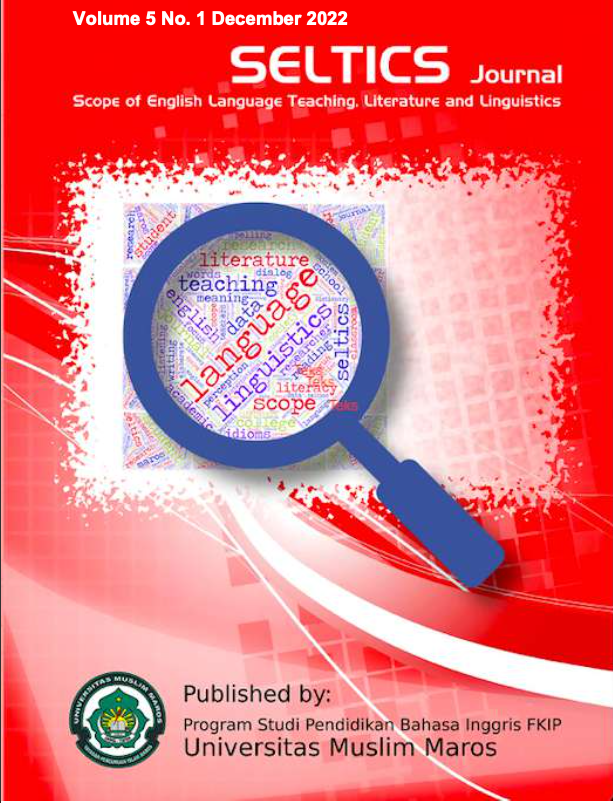Contextualisation of Direct Instruction Method in Teaching Reading Comprehension Skills: The Literature Review
DOI:
https://doi.org/10.46918/seltics.v5i1.1401Keywords:
Direct Instruction, Reading Skills, Reading ComprehensionAbstract
Direct Instruction is an approach where a teacher becomes the center of the teaching process. This teaching strategy is suitable to teach reading comprehension skills. In the process of using the Direct Instruction, a teacher needs to apply three basic concepts those are delivery, design, and documentation which means the teacher must prepare a creative lesson plan that can support students to adapt to a new concept during the ongoing process, the teacher must monitor students’ development using assessment. Some studies show that this method is effective by combining strategies or media and it can improve students’ skills. However, criticisms also hit this method. Some scholar proves from their study that this method is not always effective and is used only for students with low-level knowledge.
Keywords: Direct Instruction, Reading Skills, Reading Comprehension
References
Astri, Z. (2018). The Use Of Total Physical Response Method For Different Learning Styles In English Vocabulary. 1(1), 25–38. https://ejournals.umma.ac.id/index.php/seltics
Astri, Z., Nur, S., & Misnawati, M. (2022). Need Analysis of Pharmacy Students in TOEFL Preparation Class. VELES Voices of English Language Education Society, 6(1), 1–13. https://doi.org/10.29408/veles.v6i1.4917
Astri, Z., & Wahab, I. (2018). The Effect Of Reading Teaching Material For Different Learning Styles In Improving Students’ Reading Comprehension. Jurnal Bahasa Lingua Scientia, 10(2). https://doi.org/10.21274/ls.2018.10.2.215-230
Burden, P. R., & Byrd, D. M. (2010). Methods for effective teaching: Meeting the needs of all students: Allyn & Bacon.
Cromley, J. G., & Azevedo, R. (2007). Testing and refining the direct and inferential mediation model of reading comprehension. Journal of Educational Psychology, 99(2), 311.
Eppley, K., & Dudley-Marling, C. (2019). Does direct instruction work?: A critical assessment of direct instruction research and its theoretical perspective. Journal of Curriculum Pedagogy, 16(1), 35-54.
Ganie, R., & Rangkuti, R. J. K. s. s. (2019). Reading comprehension problems on English texts faced by high school students in medan. 684–694-684–694.
Halim, A. (2012). Pengaruh strategi pembelajaran dan gaya belajar terhadap hasil belajar fisika siswa SMP N 2 Secanggang Kabupaten Langkat. Jurnal Tabularasa, 9(2), 141-158.
Haryanto, E. J. A.-L. J. B. (2019). The Influnce of KWL Strategy Use in Teaching Reading for EFL Learners in Class Room. 8(1), 1-18.
Huitt, W., Monetti, D., & Hummel, J. (2009). Designing direct instruction. Retrived from http://www. edpsycinteractive.org.
Kaya, E. J. Ü. B. (2015). The role of reading skills on reading comprehension ability of Turkish EFL students. 4(1-2), 37.
Nanda, D. W., & Azmy, K. (2020). Poor reading comprehension issue in EFL classroom among Indonesian secondary school students: Scrutinizing the causes, impacts and possible solutions. Englisia: Journal of Language, Education, Humanities, 8(1), 12-24.
Nurdianingsih, F. (2021). teachers' Strategies in Teaching Readin Comprehension. Professional Journal of English Education, 4, 285-289. doi:10.22460/project.v4i2.p285-289
Nurdyansyah, N., & Fitriyani, T. J. U. M. S. (2018). Pengaruh strategi pembelajaran aktif terhadap hasil belajar pada Madrasah Ibtidaiyah.
PISA (2018). Program for International Student Assessment. Retrieved from https://www.oecd.org/Pisa/Combined_Executive_Summaries_PISA_2018.Pdf
Pustika, R. (2015). Improving Reading Comprehension Ability Using Authentic Materials For Grade Eight Students Of Mtsn Ngemplak, Yogyakarta. In: Published Thesis: English Education Department Faculty of Languages and Arts ….
Qrqez, M., & Ab Rashid, R. J. A. W. E. J. V. (2017). Reading comprehension difficulties among EFL learners: The case of first and second-year students at Yarmouk University in Jordan. 8.
Rusmiati, R., & Kamalina, K. (2017). The Use Of Direct Strategies In Reading Comprehension (A Descriptive Study at Senior High School Al-Falah Abu Lam U Aceh Besar). Getsempana English Education Journal, 3(2), 217646.
Sari, D. E., & Ivada, E. (2013). Penggunaan Model Direct Instruction sebagai Upaya Peningkatan Pemahaman Siswa melalui Kertas Kerja. Jupe - Jurnal Pendidikan Ekonomi, 2(1).
Shippen, M. E., Houchins, D. E., Steventon, C., Sartor, D. J. R., & Education, S. (2005). A comparison of two direct instruction reading programs for urban middle school students. 26(3), 175-182.
Sierra, E. (2012). The use of direct instruction to improve reading comprehension for students with Autism Spectrum Disorder.
Swanson, H. L., & Hoskyn, M. (1999). Definition x treatment interactions for students with learning disabilities. School Psychology Review, 28(4), 644-658.
Syamsir, N. F., Astri, Z., Suhartina, S., & Noer, F. (2021). Improving reading comprehension skill through Listen-Read-Discuss (LRD) learning strategy. Journal of Science and Education (JSE), 1(2), 60–71. https://doi.org/10.56003/jse.v1i2.28
Ulfa, S. (2011). Improving Students’ Achievement in Reading Comprehension Through Learning Together Method. REGISTER: Journal of English Language Teaching of FBS-Unimed, 1(1).
Wahyuni, S., Ritonga, H., & Anastasya, F. (2019). The Student’s Difficulties In Reading Comprehension At Second Grade At Islamic Senior High School Laboratorium Jambi. Uin Sulthan Thaha Saifuddin Jambi,
Zahriani, Z. J. L. J. (2014). Kontektualisasi direct instruction dalam pembelajaran sains. 2(1), 95-106.










